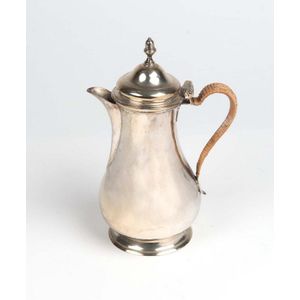Etched Claret Jug with Silver Plated Details
You must be a subscriber, and be logged in to view price and dealer details.
Subscribe Now to view actual auction price for this item
When you subscribe, you have the option of setting the currency in which to display prices to $Au, $US, $NZ or Stg.
- Edwardian - The Edwardian period of English furniture and decorative arts design is named for Edward VII (1841 ? 1910) who was King of the United Kingdom and the British Dominions and Emperor of India for the brief period from 1901 until his death in 1910. It follows the Victorian period, in turn was followed by the Art Nouveau and Art Deco styles. In Australia, designs of this period are also known as being in the Federation style.
- Heraldic Decoration - Heraldic decoration on silver, glass, and porcelain refers to the use of coats of arms and other heraldic symbols as decorative motifs on these materials. Coats of arms were traditionally used to identify individuals, families, and institutions, and were often displayed on shields, banners, and other objects.
The heraldic decoration typically takes the form of engraved or etched designs that incorporate coats of arms or other heraldic symbols. Heraldic decoration on silver, glass, and porcelain has a long history, dating back to the medieval period when coats of arms were first used. During the Renaissance and Baroque periods, heraldic decoration on decorative objects became increasingly elaborate and ornate, with finely detailed designs that often incorporated intricate scrollwork, mythological figures, and other decorative motifs.
In the 18th and 19th centuries, heraldic decoration became particularly popular among the aristocracy and upper classes, who used these objects as symbols of their wealth and status. - Finial - An architectural decoration, found on the upper parts of of an object. On furniture they are usually found on pediments, canopies and shelf supports. On smaller ceramic or silver items, such as spoons, they may decorate the top of the item itself, or the lid or cover where they provide a useful handle for removal.
Finials have a variety of shapes and forms. They may be urn-shaped, baluster shaped round or spiral, but usually taper into an upper point. Many real life shapes may also be used as finials, such as pineapples, berries, pinecones, buds, lotus and acorns. Sometimes animals such as a lion are depicted, or fish and dolphins. - Bacchus Motif - The Bacchus motif is a design that features the Roman god Bacchus, who is the god of wine, parties, and celebration. Bacchus is often depicted as a young man with long hair and a beard, holding a bunch of grapes or a wine cup. The Bacchus motif is often used in art and design as a symbol of abundance, revellery, and enjoyment. It can be found on a variety of decorative items, including glassware, ceramics, and other home decor items. The Bacchus motif represents the joy and celebration that can be found in social gatherings and the pleasures of good food and drink.
This item has been included into following indexes:
Visually similar items

19th century Dutch silver chocolate pot, maker's mark underneath, lion Passant.833/1000 with export key. Rich decoration of village scene with traders and flying birds, also windmill and church scene with figures and with upstanding lion finial. Height 23

A George II sterling silver baluster chocolate pot by Thomas Wallis I, London 1759, with domed cover and acorn finial, 21 cm high, 380 grams

Mappin & Webb claret jug plated mount with acanthus top scroll handle and fluted spout on baluster cut glass body

A George III sterling silver tankard, William and James Priest, London, 1767, the baluster form tankard with bright cut crest having a stepped dome top lid, loop thumbpiece surmounting the handle with heart shaped terminal 840gms, 20 cm high
